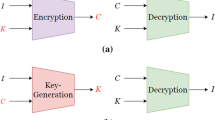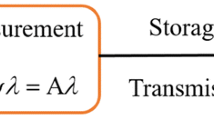Abstract
Visually meaningful image encryption (VMIE) means that a plain image is transformed into a visually meaningful cipher image which makes the plain image more imperceptible than the noise-like cipher image generated by traditional image encryption algorithms. In essence, existing VMIE algorithms exploit the idea of information steganography, i.e., embedding a secret into a host image to generate a cipher image which is visually similar to the original host image. However, it is well known that steganalysis technique is a fatal threat to steganography. Therefore, the security of existing VMIE algorithms will be potentially threatened by steganalysis technique. To improve the security of VMIE algorithms, we propose a new VMIE framework with dual embedding model. In the new framework an additional embedding phase is added. More specifically, in the first embedding process, the pre-encrypted image is embedded into the reference image to generate a visually meaningful reference cipher image. In the second embedding process, the difference between the visually meaningful reference cipher image and the original reference image is calculated to obtain a deviation matrix. Then, the deviation matrix is used as the disguised information and then embedded into the disguised host image to obtain a disguised visually meaningful encrypted image. The reference image can be any image with specified size thus ensuring the security of the VMIE algorithm. To verify the validity of the proposed VMIE framework, an example algorithm is proposed. Simulation results and performance analyses show that the example algorithm has a high time efficiency, high robustness and security.










Similar content being viewed by others
References
Armijo-Correa JO, Murguía JS, Mejía-Carlos M, Arce-Guevara VE, Aboytes-González JA (2020) An improved visually meaningful encrypted image scheme. Opt Laser Technol 127:106165
Bao L, Zhou Y (2015) Image encryption: generating visually meaningful encrypted images. Inf Sci 324:197–207
Calderbank AR, Daubechies I, Sweldens W, Yeo BL (1998) Wavelet transforms that map integers to integers. Appl Comput Harmon Anal 5(3):332–369
Cao X, Wei X, Guo R, Wang C (2017) No embedding: a novel image cryptosystem for meaningful encryption. J Vis Commun Image Represent 44:236–249
Cao Y, Zhou Z, Sun X et al (2018) Coverless information hiding based on the molecular structure images of material. Comp Mater Cont 54:197–207
Chai X, Chen Y, Broyde L (2017) A novel chaos-based image encryption algorithm using DNA sequence operations. Opt Lasers Eng 88:197–213
Chai X, Gan Z, Chen Y, Zhang Y (2017) A visually secure image encryption scheme based on compressive sensing. Signal Process 134:35–51
Chai X, Zheng X, Gan Z, Han D, Chen Y (2018) An image encryption algorithm based on chaotic system and compressive sensing. Signal Process 148:124–144
Chai X, Gan Z, Yuan K, Chen Y, Liu X (2019) A novel image encryption scheme based on DNA sequence operations and chaotic systems. Neural Comput & Applic 31:219–237
Chai X, Wu H, Gan Z et al (2020) An efficient visually meaningful image compression and encryption scheme based on compressive sensing and dynamic LSB embedding. Opt Lasers Eng 124:105837
Chai X, Wu H, Gan Z, et al. (2020) Hiding cipher-images generated by 2-D compressive sensing with a multi-embedding strategy. Signal Processing:107525
X. Chen, H. Sun, Y. Tobe, et al. (2015) Coverless information hiding method based on the Chinese mathematical expression. International Conference on Cloud Computing and Security. Springer, Cham, pp.133–143
Hua Z, Zhou Y (2016) Image encryption using 2D logistic-adjusted-sine map. Inf Sci 339:237–253
F. Jie, P. Ping, G. Zeyu, et al. (2019) A meaningful visually secure image encryption scheme. 2019 IEEE Fifth International Conference on Big Data Computing Service and Applications (Big Data Service). IEEE, pp.199–204
Kanso A, Ghebleh M (2017) An algorithm for encryption of secret images into meaningful images. Opt Lasers Eng 90:196–208
Karampidis K, Kavallieratou E, Papadourakis G (2018) A review of image steganalysis techniques for digital forensics. J Info Secur Appl 40:217–235
Li M, Fan H, Ren H et al (2018) Meaningful image encryption based on reversible data hiding in compressive sensing domain. Secur Commun Netw 2018:9803519
Liu W, Sun K, Zhu C (2016) A fast image encryption algorithm based on chaotic map. Opt Lasers Eng 84:26–36
Nandur D, Vanamala HR (2018) Visually meaningful encrypted images using Arnold transform and other transforms. 2018 International Conference on Computing, Power and Communication Technologies (GUCON). IEEE, pp. 322–326.
Ping P, Fu J, Mao Y, Xu F, Gao J (2019) Meaningful encryption: generating visually meaningful encrypted images by compressive sensing and reversible color transformation. IEEE Access 7:170168–170184
Ponuma R, Amutha R, Aparna S et al (2019) Visually meaningful image encryption using data hiding and chaotic compressive sensing. Multimed Tools Appl 78:25707–25729
Sun S (2016) A novel edge based image steganography with 2k correction and Huffman encoding. Inf Process Lett 116:93–99
Tuncer T, Dogan S, Tadeusiewicz R, Pławiak P (2019) Improved reference image encryption methods based on 2K correction in the integer wavelet domain. Int J Appl Math Comput Sci 29:817–829
Vanamala HR, Nandur D (2019) Genetic algorithm and chaotic maps based visually meaningful image encryption. TENCON 2019-2019 IEEE Region 10 Conference (TENCON). IEEE, 892-896
Wang H, Xiao D, Li M, Xiang Y, Li X (2019) A visually secure image encryption scheme based on parallel compressive sensing. Signal Process 155:218–232
Xu Q, Sun K, Zhu C (2020) A visually secure asymmetric image encryption scheme based on RSA algorithm and hyperchaotic map. Phys Scr 95:035223
Yang YG, Tian J, Lei H, Zhou YH, Shi WM (2016) Novel quantum image encryption using one-dimensional quantum cellular automata. Inf Sci 345:257–270
Yang YG, Zhang YC, Chen XB, Zhou YH, Shi WM (2018) Eliminating the texture features in visually meaningful cipher images. Inf Sci 429:102–119
Yang YG, Guan BW, Li J et al (2019) Image compression-encryption scheme based on fractional order hyper-chaotic systems combined with 2D compressed sensing and DNA encoding. Opt Laser Technol 119:105661
Yang YG, Zou L, Zhou YH, et al. (2020) Visually meaningful encryption for color images by using Qi hyper-chaotic system and singular value decomposition in YCbCr color space. Optik:164422
Zhou Z, Mu Y, Wu QJ (2019) Coverless image steganography using partial-duplicate image retrieval. Soft Comput 23:4927–4938
Zou L, Sun J, Gao M, Wan W, Gupta BB (2019) A novel coverless information hiding method based on the average pixel value of the sub-images. Multimed Tools Appl 78:7965–7980
Jiang DH, Xu GB (2020) Nonlocal sets of orthogonal product states in an arbitrary multipartite quantum system. Phys Rev A 102:032211
Acknowledgments
This work was supported by the National Natural Science Foundation of China (Grant No. 62071015); Beijing Municipal Science & Technology Commission (Project Number: Z191100007119004); Beijing Natural Science Foundation (Grant No. 4182006); Guangxi Key Laboratory of Cryptography and Information Security (No. GCIS201810).
Author information
Authors and Affiliations
Corresponding author
Additional information
Publisher’s note
Springer Nature remains neutral with regard to jurisdictional claims in published maps and institutional affiliations.
Rights and permissions
About this article
Cite this article
Yang, YG., Wang, BP., Yang, YL. et al. Dual embedding model: a new framework for visually meaningful image encryption. Multimed Tools Appl 80, 9055–9074 (2021). https://doi.org/10.1007/s11042-020-10149-4
Received:
Revised:
Accepted:
Published:
Issue Date:
DOI: https://doi.org/10.1007/s11042-020-10149-4




